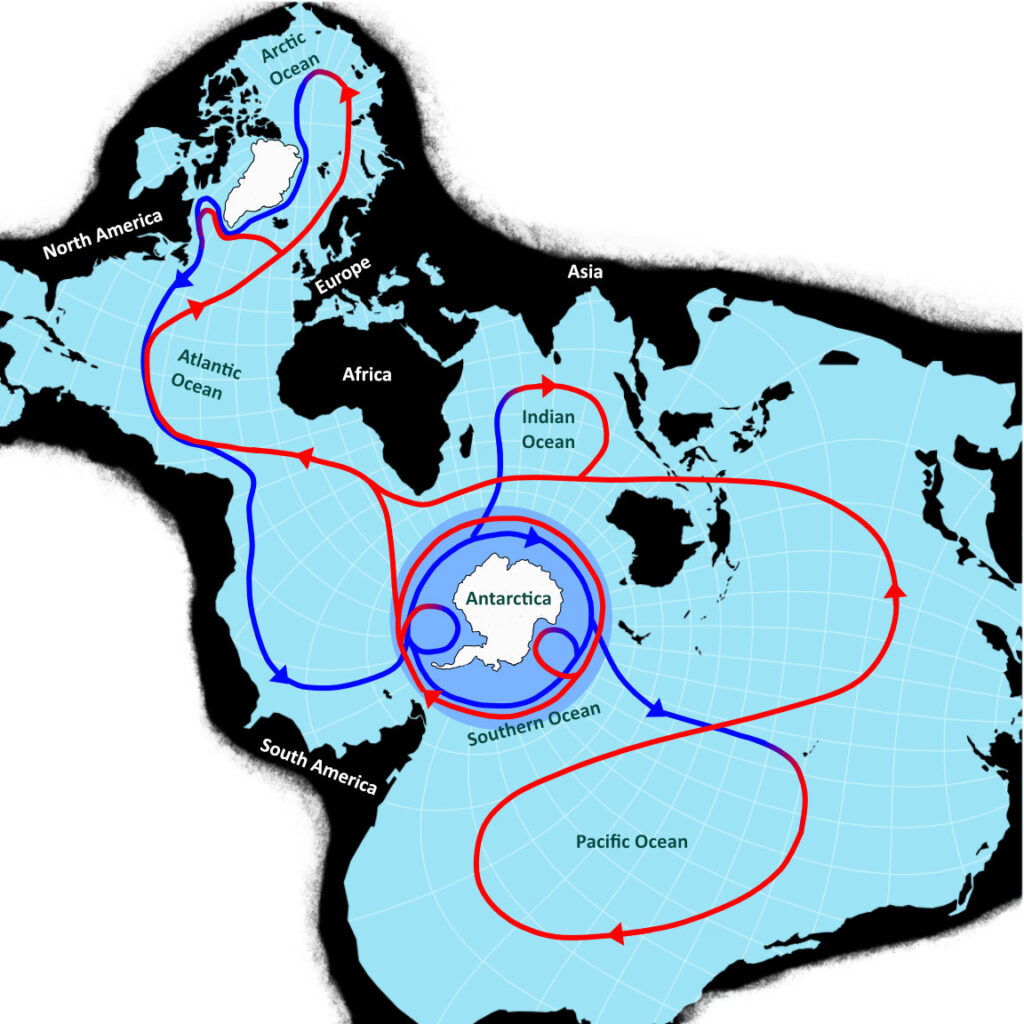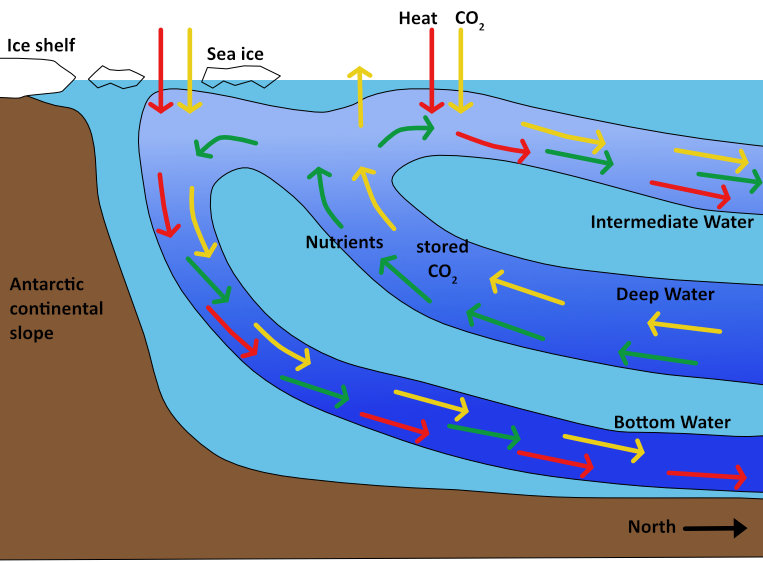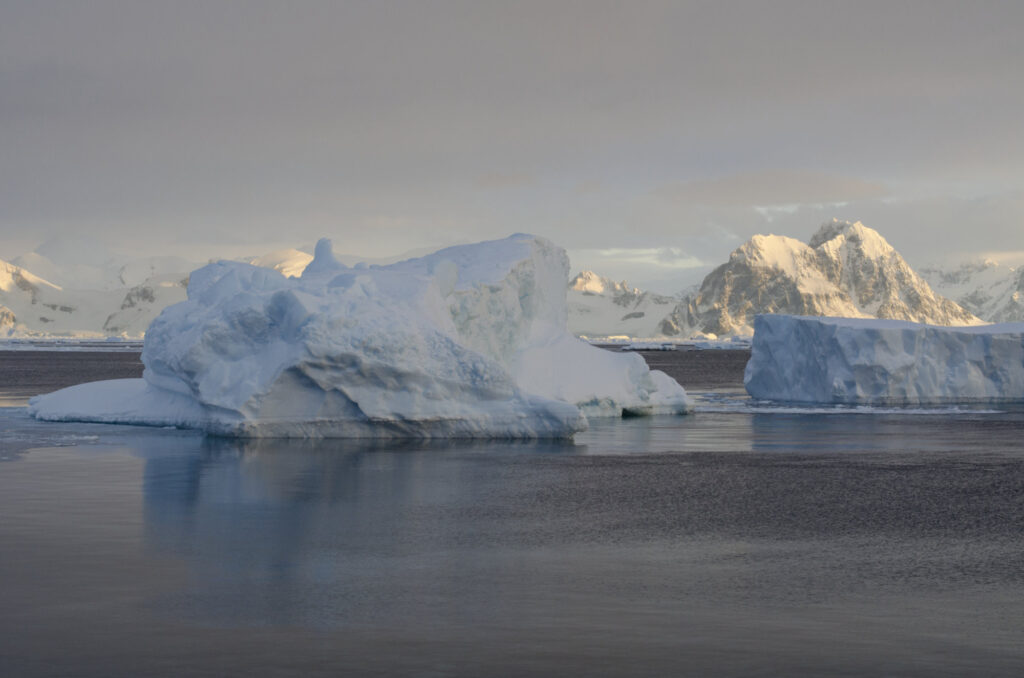The continued use of fossil fuels and changes in land use, such as deforestation for agricultural use, have led to a sharp increase in carbon dioxide levels in the atmosphere. This is rapidly changing the planet’s climate with many risks for humans, such as sea level rise and an increase in extreme weather events. The ocean significantly dampens the warming of the atmosphere. Overall, it has absorbed more than 25 percent of human carbon dioxide emissions and more than 90 percent of the additional heat brought into the climate system by greenhouse gases. As a result, the ocean significantly slows down global warming. But heat and carbon dioxide are not stored everywhere in the ocean. The absorption and storage of heat and anthropogenic carbon dioxide is closely intertwined with ocean circulation.
The Southern Ocean around the Antarctic continent takes up about 25 percent of the global ocean surface but has absorbed about 50 percent of the excess heat since 2005. The Southern Ocean also absorbs more anthropogenic carbon dioxide from the atmosphere (40 percent) than its surface area would suggest. Therefore, the Southern Ocean plays a special role in slowing down climate change.
How does the Southern Ocean store heat and carbon dioxide?
Carbon dioxide is absorbed from the air at the sea surface and dissolved in seawater. The temperature and salinity of the surface water determine how much carbon dioxide can be dissolved in the water. Warm, salty water can only absorb a small amount of carbon dioxide. The colder and less salty the water is, the more carbon dioxide is dissolved.
The transport of carbon dioxide into the deep ocean takes place through two different processes, the so-called physical pump and the biological pump.
The physical pump
The physical Pump is the major pathway for the transport of man-made carbon dioxide emissions and heat into the deep ocean. It is driven by global ocean currents due to differences in temperature and salinity in the ocean. In key regions, the water masses on the ocean surface cool down considerably, so that they become denser and heavier and eventually sink. Through this, the dissolved carbon dioxide is transported into the deep ocean. This process happens mainly in the polar regions and in the subpolar North Atlantic. From there, the water masses begin a long journey with the deep ocean currents through all ocean basins. The carbon dissolved in the water remains out of the atmosphere for decades to centuries.


The physical pump is particularly strong in the Southern Ocean. The reason for this is the Antarctic Circumpolar Current – the main driver of the global ocean circulation and a crucial modulator of the global climate. The Circumpolar Current is by far the strongest ocean current on Earth. It is driven by strong westerly winds and density differences between the warm subtropics and the icy Antarctic.
A large part of the heat and carbon dioxide uptake takes place in the area of the Circumpolar Current. South of the Circumpolar Current, deep water rises and absorbs new carbon dioxide from the atmosphere at the surface. Through cooling, the water then sinks at the northern edge of the Circumpolar Current and flows northward. This so-called Antarctic Intermediate Water can reach the temperate northern latitudes. This is one of the main transport routes for anthropogenic carbon dioxide into the ocean interior. The ocean regions in which intermediate water is formed have warmed much faster than the world ocean in the last fifty years.
Another part of the upwelling deep water reaches the Antarctic continental slope. Cooling through contact with the atmosphere, enrichment with brine through sea ice formation and interactions with the adjacent ice shelf create very heavy water masses. These flow down the continental slope to the ground, taking along considerable amounts of the surrounding water. The Antarctic Bottom Water created in this way spreads with the Circumpolar Current to subsequently fill all the deep basins of the world’s oceans. Due to the previous contact with the atmosphere, the bottom water also carries anthropogenic carbon dioxide. The physical pump will lose efficiency due to higher water temperatures caused by global warming.
The biological pump
The biological pump transports carbon dioxide bound by algae into the deep ocean. In the light-flooded surface water (upper 100 meters) single-celled algae (phytoplankton), macroalgae, and seagrasses photosynthesize. This means that they use the carbon dioxide dissolved in the water to build up biomass using solar energy and nutrients. This is the basis of the oceanic food webs. In the Southern Ocean, nutrients are brought to the surface with the upwelling deep water. This results in particularly abundant phytoplankton production. The carbon bound in the algae can migrate through the entire oceanic food web, from small crustaceans and various fish species to marine mammals such as whales and seals. Some of the carbon is converted back into biomass as muscle meat or fat, some is respired and released back into the seawater as carbon dioxide, and some sinks to the sea floor in the form of excrement. Dead algae or marine animals also sink to the sea floor. On the way there, they are decomposed by bacteria or consumed by deep-sea organisms. Residual quantities that reach the bottom are stored in the sediment. By that, the carbon is removed from the natural cycle for a very long time. For the further development of climate change, it is important how much biomass sinks below the upper layer of the ocean, which is mixed by wind and waves. The biomass-bound carbon that reaches the intermediate and deep water is trapped there for decades to centuries.
What is research working on?
Over the last fifty years, the Southern Ocean has warmed much faster than the world ocean below a depth of around 1000 meters. Extensive observations are necessary to determine how the physical and biological pumps are changing in the Southern Ocean and to assess global consequences.
Paleoclimate data are necessary to better document long-term climate mechanisms and to improve models. In addition to carbon dioxide measurements from ice cores, paleoclimate data from sediment cores going back much further in time are important. Sediment cores provide an insight into periods that were warmer than today. They are particularly valuable for our understanding of future climate development.
How do climate change and increasing atmospheric carbon dioxide concentrations affect the absorption and distribution of heat and carbon in the Southern Ocean?
Carbon dioxide uptake in the Southern Ocean may change significantly within a few years. In the 1990s, carbon dioxide uptake stagnated but increased considerably in the following 2000s. It is not yet clear which processes play the most important role here and whether incomplete observations lead to an overestimation of the fluctuations.
It is also unclear whether models underestimate these fluctuations in carbon dioxide uptake.
We know from paleoclimate data that significant changes in the westerly winds have taken place in the course of warming. A strengthening of the westerly winds has already been observed in recent decades. This has led to increased upwelling of carbon-rich deep water, increased formation of Antarctic Intermediate Water, and an increase in eddies. It is unknown what role eddies will play in the future for the uptake and storage of heat and carbon.
Another change that has occurred repeatedly in recent years is the large-scale Weddell polynya, in which deep water formation takes place. It is unclear whether this phenomenon will occur regularly or even more frequently as a result of climate change.
How will expected changes in biological productivity and species composition affect carbon uptake in the Southern Ocean?
Experiments show that plankton, the basis of marine food webs, is sensitive to expected future environmental changes. So far, no large-scale changes in plankton composition or biological productivity have been observed. Biological productivity is the total amount of biomass produced by living organisms in a given area within a given period of time. Thus, no change in the biological pump has been observed so far.
It is difficult to model the role of different plankton groups in carbon and nutrient cycling under changing environmental conditions. Predictions of biological productivity are based on a highly simplified understanding of processes and are therefore still very uncertain.
What are the global consequences of changes in the Southern Ocean?
Changes in heat and carbon uptake in the Southern Ocean will also affect the global ocean and atmosphere. Many research questions still need to be answered, such as: Where and when do carbon and heat absorbed in the Southern Ocean come back in contact with the atmosphere? How is this influenced by changes in nutrient transport?
To understand the effects of changes in the Southern Ocean on the global climate, sediment cores have been taken from a network spanning the world’s oceans over the last few decades. This has provided insights into past environmental changes. Due to this, it is known that the Antarctic Circumpolar Current plays a key role in global climate fluctuations. Reconstructions of the position and strength of the Circumpolar Current during earlier warming phases can provide far-reaching insights for our future. However, there are still large gaps in sediment core sampling in the Southern Ocean that need to be filled.
How will changes of the ocean circulation affect the heat and carbon uptake? How will this change processes such as ocean acidification, biological productivity, and carbon storage?
Ice and sediment cores have shown that carbon dioxide concentrations in the atmosphere over the last 800,000 years have been closely linked to Antarctic air and water temperatures. The biological and physical pumps in the Southern Ocean have significantly controlled the natural carbon dioxide fluctuations between warm and ice ages. This coupling occurs through current changes in the vicinity of the Antarctic Circumpolar Current, which influence the input of the nutrient iron from atmospheric dust into the Southern Ocean. This affects the growth of algae and consequently the effectiveness of the biological pump. Disruption of this delicate balance by climate and environmental changes (such as ocean acidification) can have a significant impact on atmospheric carbon dioxide concentrations and thus on global warming. To better understand carbon uptake and storage, it is necessary to investigate how much biologically bound carbon reaches the deep ocean and which processes influence this. This requires field observations and experiments with key species under controlled conditions.
Better model simulations are needed to be able to estimate future changes due to climate change. At present, the two carbon pumps cannot yet be represented realistically in Earth system models. To achieve this, processes such as oceanic eddies, their interactions with the increased westerly winds, and Antarctic Bottom and Intermediate Water formation must be represented on the scale of a few kilometers. This requires enormous computing power. Changes, such as the increased meltwater input from icebergs and ice shelves, must also be integrated into the models.
